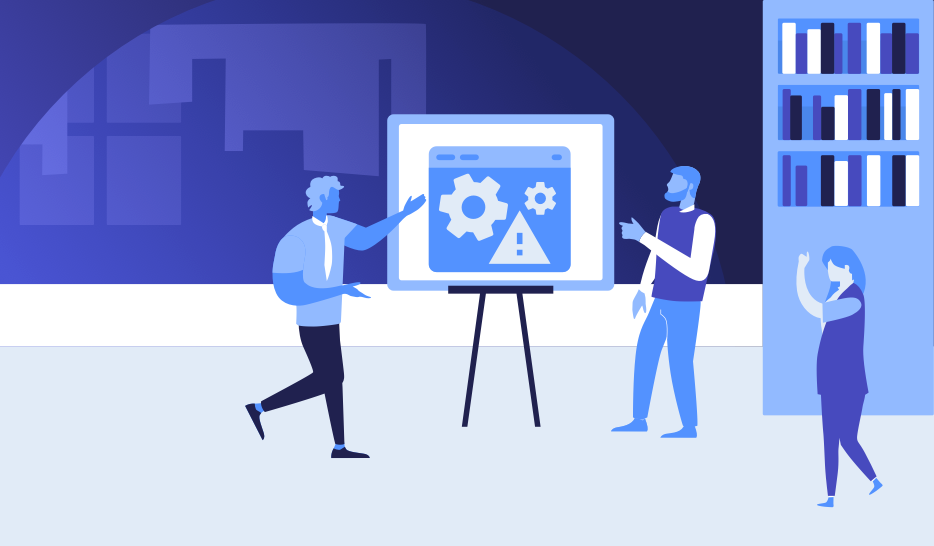

No matter the industry, executives everywhere currently face the increasing challenges of software being a key technology and a critical component of business success. In a climate where software is becoming a key, long-term success factor regardless of the industry, some important questions come to light in terms of the relationship between C-level employees and software. Should executives care about software technology, and if so, to what extent? Should executives themselves better have experience in software management?
A recent article titled ‘The Top 10 Things Executives Should Know About Software’ by Thomas A. Limoncelli addresses this question, highlighting the fundamental challenges that IT executives face as the digital transformation progresses to affect almost all industries substantially. Jumping off from Limoncelli’s text, this blog will move through a discussion of whether software analytics help to address these key challenges. The aforementioned article can be found at this link. 
Limoncelli’s article illustrating the urgency of a progressive relationship between management personnel and software, published on the website Communications of the ACM.
Software analytics denote analytics on software data, where the analytics collect, analyze, evaluate and explore data about software development processes, source code, system evolution, and software developers. The discipline covers all phases of the software development process, including release management and operations. It is therefore a key element for organizations that need to cope with fundamental risks and tasks in software management.
Certain data analytics platforms that focus on software have been developed in recent times, helping companies bridge the gap between software development and executives. Seerene’s platform for software analytics provides a ‘Digital Boardroom’ for decision-makers in software engineering, providing features for monitoring, steering, benchmarking, and target control. This not only addresses the needs of the technical management, but also support executives in understanding and reflecting upon software development processes.
As highlighted in Limoncelli’s article, software’s uniqueness focuses around 10 central features where software analytics can come in to transform the dynamic of a software organization.
In order to bring software projects to life, a team of many different kinds of people with diverse degrees of qualification work in different roles to enable the complex, industrial manufacturing processes that lie in software. The perceived magic of this situation includes both the creation process of software, and its functionality that comes as a result. For the former, software analytics provide fast, accurate, and unbiased insights into these processes, casting focused light onto the magic of software. For the latter, software analytics go one step further, demystifying software engineering and so bringing it much closer to a state of real engineering; less reliant on intuition, and more on hard data that has been deduced from present engineering processes.
The Seerene platform allows you to get detailed insights into the changes your team performed on the software, which includes, for example, effort estimation and objective measurement of the software.
Much like a company’s website, an entire software product is in a constant state of being under construction. For this reason, software analytics must be equally continuous, and analyze software development on a day-to-day basis, throughout its lifecycle, providing up-to-date insights into quality, risks and development at any time.
Catering to this need, Seerene’s platform offers a kind of digital boardroom for all responsible stakeholders that provides up-to-date, accurate information on software that is constantly changing.
All non-trivial software projects are based on large teams that change over time. Software management needs to be able to get a transparent, objective view of how teams work, and how they can be best put together. On this level, software analytics provide the ability to understand the strengths of teams and to optimize their composition by analyzing past software development activities and predicting future needs. In a sense, software analytics is not just about code: it’s about code and people.
The design of systems are implemented by a range of complex subsystems, such as user interfaces, front-ends, and application frameworks. The more elegant, simple and self-explanatory the design is, the more complex their implementation becomes.
Software analytics monitor and evaluate the development of complex systems constantly, giving software managers the tools that they need to control, discuss and compare the development at every moment.
Dealing with security requirements, features and vulnerabilities is an essential and important part of professional software development. When it comes to security, it’s not just about having the right technologies in place, but also about the corresponding processes.
When it comes to implementing or adjusting security issues, software analytics can identify the relevant fields in an IT landscape. For example, the analytics identify source code that matches with vulnerability databases, so filtering out the modules that are likely to be the best candidates for security issues.
Contrary to common logic, small features can require a great investment of development effort. As a result, management employees without expertise in software can be left scratching their heads over this non-correlative relationship between feature size and development effort.
Using software analytics allows us to analyze the effort required to implement functions and create cross-project benchmarks. And as machine learning integrates with software analytics, it becomes possible to predict the implementation effort needed for future features, or to approximate the effort spent previously.
Software systems evolve over time as developers add, remove or modify functions and implementations gradually. It is only through this principle of evolution that robust, powerful systems can be created.
Focusing on system evolution, software analytics offer the possibility of tracking, monitoring, evaluating and predicting all key indicators automatically. This allows us to observe how aspects like the quality, risk and development of system components change over time.
The concept of technical debt refers to the future obligations caused by the current implementation of system components, and can be considered as a kind of ‘natural’ effect in software development. However, this debt needs to be dissolved at the right time, otherwise causing subtle damage and inducing negative side effects. However, understanding which technical debt should be removed at the right time is a complex process, as some areas of debt are more urgent than others.
As a result, technical debt must be managed sensitively and software analytics help out with this phase by determining, visualizing and comparing the technical debt in a system’s implementation accurately. By offering a clear evaluation on the nature and location of this debt, are very helpful to software management for creating a strategy on how to handle this challenge.
In the example below, a Seerene software map shows technical debt for the QT application framework (version 5.12). This library consists of approx. 103k modules. The footprint size of each module in the map corresponds to the number of “real lines of code” (RLoC), the height reflects the algorithmic complexity (“McCabe Complexity”) and the color shows how many comments are found in the corresponding source code. Obviously, large, complex modules with poor comments are more likely to accumulate technical debt and should be re-engineered soon. With Seerene’s interactive, up-to-date software maps, teams can plan, discuss, and monitor technical debt.
Operations are an integral part of a software-based system, and although operational features are almost invisible to the users, any failure can cause significant trouble including malfunction and perhaps the full outage of a system.
Although it is easy to believe that software analytics could be code and developer-centric, they are also able to account for performance and execution measures such as actual use of features, memory consumption, energy consumption and user logs. To this end, analytics allow us to generate a holistic view on software, its development and its operation.
As a concept that breaks down the traditional border between developers and operators, DevOps must work across department silos.
Software analytics aim at connecting and fusing all data silos of software systems into a single, analytics information space, giving appropriate actionable insights to everyone involved. This way, the analytics help to overcome communication barriers and strengthen the DevOps field of a company’s organization.
Get your whole team closer to your software development process with the power of software analytics, as full transparency across the end-to-end process allows for the informed, accurate management of software teams. Find out more about Seerene here.
These Stories on News
August-Bebel-Str. 26-53
14482 Potsdam, Germany
hello@seerene.com
+49 (0) 331 706 234 0
Generative AI Seerene GmbH
August-Bebel-Str. 26-53
14482 Potsdam, Germany
hello@seerene.com
+49 331 7062340